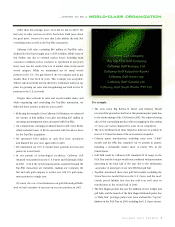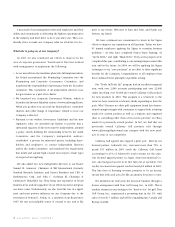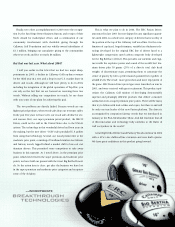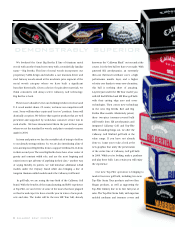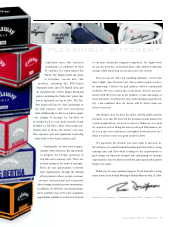Callaway 2003 Annual Report Download - page 16
Download and view the complete annual report
Please find page 16 of the 2003 Callaway annual report below. You can navigate through the pages in the report by either clicking on the pages listed below, or by using the keyword search tool below to find specific information within the annual report.
CALLAWAY GOLF COMPANY 13
Income Taxes
Current income tax expense is the amount of income taxes
expected to be payable for the current year. A deferred income
tax asset or liability is established for the expected future
consequences resulting from temporary differences in the
financial reporting and tax bases of assets and liabilities. The
Company provides a valuation allowance for its deferred tax
assets when, in the opinion of management, it is more likely
than not that such assets will not be realized. While the
Company has considered future taxable income and ongoing
prudent and feasible tax planning strategies in assessing the
need for the valuation allowance, in the event the Company
were to determine that it would be able to realize its deferred
tax assets in the future in excess of its net recorded amount, an
adjustment to the deferred tax asset would increase income in
the period such determination was made. Likewise, should the
Company determine that it would not be able to realize all or
part of its net deferred tax asset in the future, an adjustment to
the deferred tax asset would be charged to income in the period
such determination was made.
Change in Accounting Estimate
As discussed above, the Company has a stated two-year
warranty policy for its Callaway Golf clubs, although the
Company’s historical practice has been to honor warranty
claims well after the two-year stated warranty period. Prior to
the third quarter of 2002, the Company’s method of estimating
both its implicit and explicit warranty obligation was to utilize
data and information based on the cumulative failure rate by
product after taking into consideration specific risks the
Company believes existed at the time the financial statements
were prepared. These additional risks included product-specific
risks, such as the introduction of products with new technology
or materials that would be more susceptible to failure or
breakage, and other business risks, such as increased warranty
liability as a result of acquisitions. In many cases, additions to
the warranty reserve for new product introductions have been
based on management’s judgment of possible future claims
derived from the limited product failure data that was available
at the time.
Beginning in the second quarter of 2001, the Company began
to compile data that illustrated the timing of warranty claims in
relation to product life cycles. In the third quarter of 2002, the
Company determined it had gathered sufficient data and
concluded it should enhance its warranty accrual estimation
methodology to utilize the additional data. The analysis of the
data, in management’s judgment, provided management with
more insight into timing of claims and demonstrated that some
product failures are more likely to occur early in a product’s life
cycle while other product failures occur in a more linear fashion
over the product’s life cycle. As a result of its analysis of the
recently collected additional information, the Company
believes it has gained better insight and improved judgment to
more accurately project the ultimate failure rates of its products.
As a result of this refinement in its methodology, the Company
concluded that it should change its methodology of estimating
warranty accruals and reduce its warranty reserve by approxi-
mately $17.0 million. The $17.0 million reduction is recorded
in cost of sales and favorably impacted gross profit as a
per
centage of net sales by 2 percentage points for the year
ended December 31, 2002. The change in methodology has
been accounted for as a change in accounting principle
inseparable from a change in estimate.
The following summarizes what net income and earnings per
share would have been had the warranty reserve adjustment,
adjusted for taxes, been excluded from reported results:
Year Ended December 31,
(In millions, except per share amounts) 2002
Reported net income $ 69.4
Non-cash warranty reserve
adjustment, net of tax (10.5)
Pro forma net income $ 58.9
Basic earnings per share:
Reported net income $ 1.04
Non-cash warranty reserve
adjustment, net of tax (0.16)
Pro forma basic earnings per share $ 0.88
Diluted earnings per share:
Reported net income $ 1.03
Non-cash warranty reserve
adjustment, net of tax (0.16)
Pro forma diluted earnings per share $ 0.87


